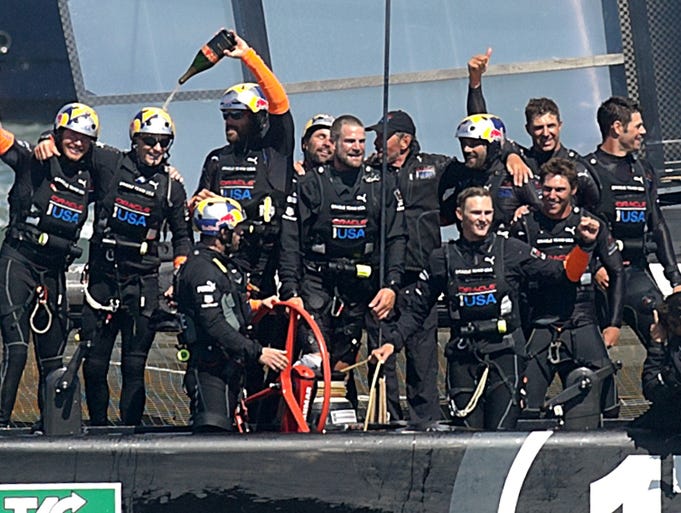After falling behind 8-1, the American team under never-say-die skipper Jimmy Spithill captured eight consecutive races to win 9-8 in the first-to-nine-wins series. Oracle won 11 races but was hit with a two-race penalty for cheating in a warm-up race with smaller boats.
The deciding race didn't start well for Oracle. The Kiwis took advantage of their port position at the start and maintained an early seven-second lead at Mark 1 as Oracle plunged its two bows into the water while making the turn. But after three lead changes in the third upwind leg – once the Americans' weakness – Oracle sailed away with a 44-second victory.
At the finish line, the team erupted into hugs and high-fives and were then joined by Larry Ellison, the billionaire Oracle owner, for a champagne shower aboard the AC72 class of yacht.
"Oh man, oh man, What a race!" said Australia's Spithill, now a two-time America's Cup winner. "It was a fantastic race. We wouldn't have had it any other way. To come from behind, these guys just showed so much heart."
New Zealand skipper Dean Barker was heartbroken after the defeat. His boat sailed flawlessly in the earlier rounds against Italian and Swedish challengers.
"I'm gutted that we didn't get the last one that we needed to take this Cup back to New Zealand," Barker said. "It's very hard to swallow."
Added New Zealand's tactician Ray Davies: "They deserved to win. They sailed brilliantly."
Over 162 years, America's Cup has had its share of oddball incidents, big-money participants, broken dreams and unexpected triumphs. But rarely has the drama quotient reached such heights as it has during the last week along picturesque San Francisco Bay.
Not since Australia II erased a 3-1 deficit to snag the Cup 4-3 from Dennis Conner's Liberty – ending the New York Yacht Club's 132-year stranglehold on the competition – has America's Cup offered such theater.
This is only the third time in the regatta's long history that it came down to a winner-take-all finale. The defender won in 1920 and the challenger in 1983.
It's a far cry from the last few months, when the so-called "Summer of Sailing" encountered a steady headwind.
The decision by Ellison to stage the race in gusty San Francisco in expensive, speedy but fragile multihulls looked like a poor one. The lead-up was rife with missteps, broken financial promises and tragic accidents.
The $100 million price tag dissuaded all but three groups to challenge Oracle, while San Francisco's anticipated economic boost fell below expectations.
Oracle suffered serious damage to one of its two boats when it capsized and broke apart last October. In May, British Olympian Andrew Simpson died in a training incident aboard Sweden's Team Artemis.
The race, too, appeared lopsided as New Zealand took a commanding 8-1 lead.
But Oracle fashioned a stunning rebound by making daily changes to its boat and tweaks to its crew, notably by replacing American tactician John Kostecki with four-time Olympic gold medalist Ben Ainslie of Britain.
The riveting closing stages transformed the Cup from a mess to a must-see event watched in 203 countries and territories and more than a million fans in San Francisco over the last three months.
Stephen Barclay, chief executive of the America's Cup event authority, said Wednesday that the close-to-shore race with the "best sailors in the fastest boats" amounted to a "vision delivered."
PHOTOS: 2013 AMERICA'S CUP
Gavin Newsom was the city's mayor when San Francisco was chosen to host the American's Cup. He praised Ellison at the trophy presentation.
"This race has been transformed forever because of his vision ... the greatest comeback in the history of sports," said Newsom, now the lieutenant governor of California.
Because of its strange rules that allow the winner to select everything from the venue to the type of boats used, questions abound for the next America's Cup.
Will organizers stay with a multihull configuration or return to the monohulls of the past? If they go with multihulls, will they stick with soaring 7-ton yachts fastened with 131-foot carbon-fiber sails or something less imposing?
One thing seems certain: The 35th Cup will aim to cut costs in order to encourage more participants. In 2007, the last full Cup, there were 11.
A lower bar-to-entry could mean simpler boats with more off-the-shelf parts. But the main focus will be reducing the massive on-shore staff needed to build, maintain and operate the sophisticated sailing machines, which for this regatta climbed into triple digits.
"It's not the America's Cup of old, but interesting nonetheless," four-time America's Cup winner Conner said by phone Wednesday from his home in San Diego. "It's like watching NASCAR or dragsters."
Conner, for one, expects a return to simpler designs even if he has enjoyed the AC72s dueling at previously unimaginable speeds between Alcatraz Island and the Golden Gate Bridge.
The 71-year-old celebrated yachtsman says the sailing community prefers monohulls because catamarans stray too far from "the components of real racing."
But that might be a hard sell after this year's climactic finish.
Despite his traditionalist leanings, Conner had to concede the sailing world had been glued to its chairs.
"Good exhibition," he said.


No comments:
Post a Comment